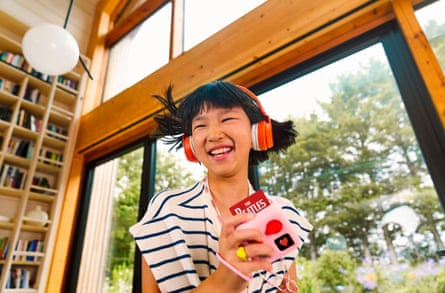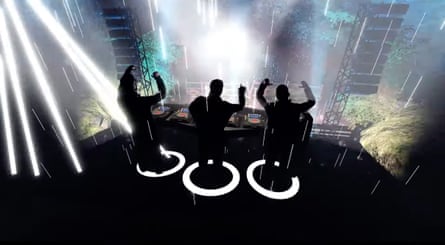My daughter is nine years old. When I was her age, in 1989, I had my own small cassette player and a beloved pile of my own tapes – brand new, or made up of songs from the radio – that I could listen to whenever I wanted. The same went for my parents’ modest CD collection (Genesis’s Invisible Touch was awesome; their three Lionel Richie albums were boring). There were a few vinyl records knocking about and there were at least two radios – invariably set to Capital FM – that I could turn on whenever.
My daughter has none of these things. The only way she can access music is by making me get my phone out and play a song on my Spotify account. The inconvenience is trifling, but more painful and alarming is the growing gap between us when it comes to musical experience.
A whole age group of kids – let’s call them “pre-phone children” – are now unable to access music of their choosing. In fact they have virtually no musical autonomy at all, not helped by plummeting investment in music tuition. As Naomi Alderman, the novelist, game writer and author of best-selling sci-fi novel The Power sees it: “So much of our technology is coded up by 25-year-olds working for companies run by 37-year-olds. They maybe have not raised children to adulthood and don’t have friends who have, so the question ‘how do I give my kid easy access to some but not all of my music’ hasn’t come up.”
There’s no concern over this and worryingly, no sense of panic about a demographic who don’t have the type of welded bond to music that only the white heat of youth can forge.
It’s that searingly hot and obsessive aspect of my formative bond with music that made me notice the stark gap between me and my daughter. She enjoys music: she knows the words to at least half of the songs from Horrible Histories, and is really into the hits they adapt or parody when I reveal them to her. But she’d rather have an audiobook over an album any day. By contrast, at age nine I actively worshipped the two jet black tapes that comprised Now That’s What I Call Music! 14 – and nothing compared to one of its hits, Buffalo Stance by Neneh Cherry. It had sounds I’d never heard and words that made no sense (what was a gigolo and why did he have crocodile feet?) but playing it 72 times in a row in my childhood bedroom – a type of experience not afforded to many pre-phone children now – made me a music fan for life.
“We have changed a lot of our infrastructure very quickly by making it digital,” says Alderman, whose recent Wired article The Danger of Digitising Everything warns of the creeping disenfranchisement of anyone without a screen – pre-phone children being obvious examples. “We have not thought enough about digital inclusion, or how to allow staggered access to digital things.”
But just because I – and I’m going to assume you – had direct access to music in our pre-teens, it doesn’t mean we’re the broad norm, as Daniel Levitin, the neuroscientist, cognitive psychologist, and bestselling author of books such as This Is Your Brain on Music is keen to point out. “For tens of thousands of years, if you wanted to hear music, you had to play it yourself – or find someone who could,” he says. “The generation I grew up in is rather privileged in that we had access to music on demand. Now we’re back where we were pre-1950 – except today, children have to find an adult who can sing to them, who can play an instrument or can push the right buttons on Spotify.”
The average age that a child acquires a phone in the UK is 11. Canvassing a music class at a secondary school in Camden almost universally confirmed – though their age of phone attainment varied from 10 to 15 – that this was when they achieved musical autonomy. “Music is basically inaccessible without a phone,” one told me. “Having control over what you listen to is important because it allows you to have your own opinions on the music you listen to,” said another.
At primary school level however, where most children are still in their pre-phone era, a huge variety of different music situations exists in every home. Overwhelmingly the most common scenario is for kids to have no direct access at all – and for a parent or carer to have to facilitate any music selection a child makes, streamed to a Bluetooth speaker or headphones, or played from phone or computer speakers. Technically nobody under 13 should be using Spotify’s main service at all.
Some households might use a retired smartphone as a safe, offline music player with playlists downloaded to it, or a child-friendly tablet, but cost is a factor and the desire to rein in screen time puts off many parents. Some households still have radios in frequent use, though mostly set to adult-oriented stations such as Kisstory or BBC 6Music.
A growing number of families have a smart speaker, and some lucky kids might have their own in their room. They are perfect for a listener who is either worldly enough to know they want to hear a certain Boz Scaggs song over breakfast, or comfortable enough in their lack of musical knowledge to just ask for something generic like “gym music”. Yet there’s no space here for a curious yet fledgling music fan who has never heard of Boz Scaggs and isn’t ready to have their listening passively curated by an algorithm.
A passion for music drove some of the biggest leaps in modern technology – Napster and its ilk introduced us to downloading and filesharing. The iPod prepared us for the iPhone, while showing off one’s music taste was integral to the first mainstream social networking site, MySpace. It’s thus strange that innovation has stagnated around products that can give today’s children the same musical autonomy, and subsequent passion, their parents had.
Yet some do exist. One is the Mighty Vibe: a small, screenless device that resembles the iPod Shuffle of yore and retails at around £100. Though it draws its content from a Spotify or Amazon playlist controlled by a grownup, a child can shuffle, skip or endlessly repeat the songs, listening via headphones or a Bluetooth speaker.

Bolder and far more autonomous is the Yoto. Accessible to children as young as two, it’s a speaker that plays from physical cards that carry songs and other audio content such as audiobooks. According to Dom Hodge, Yoto’s head of music and sound: “Because Yoto is a ‘controlled technology’, parents feel safer to allow children to use their player totally independently which in turn, makes the child feel more empowered and engaged with what they’re listening to.” Crucially, there are no mics, voice commands, cameras, ads or screens – save for a soothing pixel display that outlines what’s playing. They truly feel like a device that’s the sole, unencumbered property of its child owner. A recent deal with Warner Music Group will unlock many more well-known artists, while the Beatles and Queen recently became available. Hodge talks up the “sense of discovery” in their catalogue, citing a partnership with Brighton label Mr Bongo to introduce kids to music from Brazil, Ghana, Mali, Nigeria and Cuba.
But while the player also comes in around the £100 mark, the cards need to be purchased separately. Streaming has radically reduced the price of listening, and the cost of production software has also fallen, but kid-friendly music often remains costly. The American seven-year-old Miles Bonham has 2.7 million Instagram followers for his wonderful videos of beat-making and songwriting – but he’s doing it on ProTools with an array of mics, synths and more that would be prohibitively expensive for most families, and hollowed-out youth clubs will also struggle.
There are a few glimmers of low-cost inspiration, though. Yukee is a new animation series set in Northern Ireland that started airing on CBeebies in February. Over each seven-minute episode, we follow the eponymous hero as she jams with a new animal pal in her garden, played by the likes of Wet Leg – as a travelling troupe of snails called the Slime Sisters – plus Mercury prize-winning jazz group Ezra Collective and Weezer’s Rivers Cuomo. As with other CBeebies shows like the classical music voyages of Melody or the brassy stomp of YolanDa’s Band Jam, Yukee is a genuinely brilliant resource for musical inspiration and education that, according to co-creator Mark Gordon, “strives to avoid the well-worn cliches about what a pre-schooler should listen to. Equally, it avoids the kind of ‘nursery rhymes on steroids’ style of modern children’s content – designed to offer no musical nourishment and simply provide low level distraction”.
Kids really do need music as a form of nourishment, and it’s genuinely quite moving to discover that it has a nurturing, almost magical quality when applied to your growing DNA clone. Child psychologist Jen Lamacq says that “music is such a gift” to a developing child, citing “cognitive, language, social, emotional and even physical” learning. Levitin, currently writing his new book Music as Medicine, concurs: “As we found in my own lab, when we play or listen to music together, our brain waves literally synchronise. We release oxytocin and prolactin – a soothing hormone that is released by mothers when nursing – when we listen to music together. All these things say to us: music is supposed to be social.”
And yet, perhaps as kids get older, there should also be something antisocial about music, too – a means to preserve that vital cultural spark, the generation gap. One of the reasons I’m so concerned about my kids’ lack of musical autonomy is that I feel genuine shame that they are held hostage by my musical tastes. My parents couldn’t stand the shouty rap of Buffalo Stance while I couldn’t abide their three-album devotion to Lionel Richie – and sorry Mum, but in retrospect that Genesis album was also awful. Yet by being so dependent on the parental player, it’s harder than ever for kids to find the true voices of their era, not the increasingly irrelevant ones of mine.
It’s almost cruel then that certain things that appear to be for young music fans just aren’t. My favourite examples of this are “baby raves” or “family-friendly raves” – which often sell themselves as a nourishing musical voyage for kids, yet are mostly just an excuse for parents to get tipsy, listen to very quiet dance music of their youth, while a rudimentary “arts table” is set up to occupy the kids all day. Music media aimed at young people is mostly gone, too – the last attempt at reviving something akin to Smash Hits, the 2011-launched We Love Pop magazine, slowly mutated into a brand covering TikTok influencers before it was wound down.

A pre-phone child is more likely to forge a strong connection with gaming, given that something such as a Nintendo Switch – sealed off from the potentially dangerous open internet – is a safer device than one that can access Spotify. Though gaming may end up creating their relationship with music, according to Stuart Dredge, head of insight at Music Ally and a frequent writer on technology for the Guardian. “The music industry is working hard here: for example, there’s been a big uptick in the number of artists doing stuff on Roblox lately,” he says. “Sometimes I worry that my kids, who are 14 and 16, don’t love music like I did at their age. But then I see them singing the songs on the EA Sports FC soundtrack, or playing the new Festival music game in Fortnite, or yelling some random soft-rock track that’s unaccountably gone viral on TikTok, and I think they still have opportunities.” But the Walkman-raised part of me worries about music losing something by being totally knitted together with screen content, as a TikTok or videogame soundtrack, from an early age.
I’m not pining for a return to music videos purely on MTV, or to the ephemeral accessories of music fandom: the sleeves, artwork, gatefolds, cover mounted CDs or the posters. I just want pre-teen kids to feel free to explore the actual music before the spark of youthful curiosity is snaffled by a million online distractions. I want them to roam free, not in a walled garden of safe curated playlists such as Spotify Kids, which seems less like a nourishing mentor and more a risk-averse nanny. Naomi Alderman agrees: “You need more settings than ‘none’ or ‘all’ and you need more options than ‘give the child a whole smartphone’ vs ‘they can’t play music at all’.”
And yet, for the time being, my kids are still tethered to me sonically. I played Buffalo Stance to my nine-year-old recently. She didn’t hate it. As those chiming last notes rang out and my heart fluttered for the millionth time, she surmised: “Yes, I can see why you would have liked that,” and walked off. Sadly, she didn’t close her bedroom door and blare out some deeply objectionable noise by a band I’d never heard of. I would have loved that.
Source: theguardian.com


